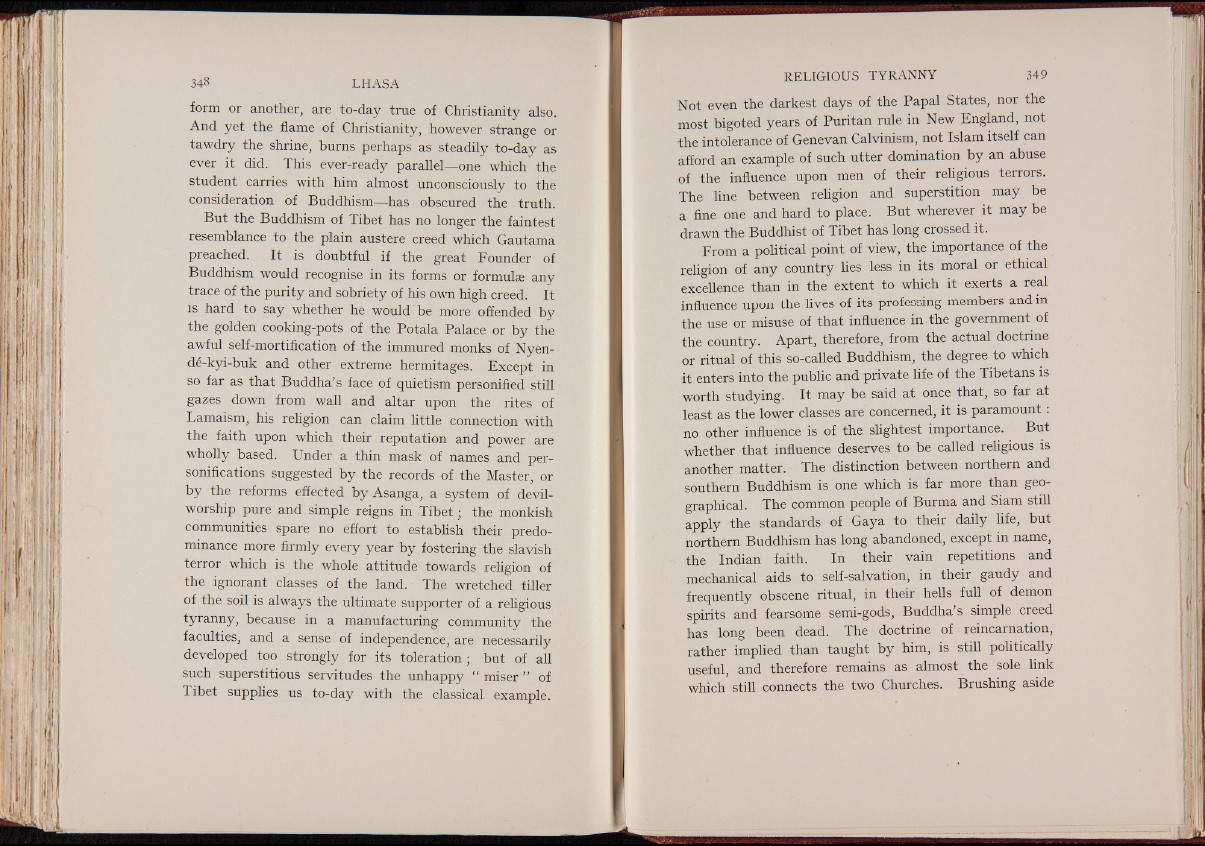
form or another, are to-day true of Christianity also.
And yet the flame of Christianity, however s t r a n g e or
tawdry the shrine, burns perhaps as steadily to-day as
ever it did. This ever-ready parallel— one which the
student carries with him almost unconsciously to the
consideration of Buddhism— has obscured the truth.
But the Buddhism of Tibet has no longer the faintest
resemblance to the plain austere creed which Gautama
preached. It is doubtful if the great Founder of
Buddhism would recognise in its forms or formulae any
trace of the purity and sobriety of his own high creed. It
is hard to say whether he would be more offended by
the golden cooking-pots of the Potala Palace or by the
awful self-mortification of the immured monks of Nyen-
de-kyi-buk and other extreme hermitages. Except in
so far as that Buddha’s face of quietism personified s t i l l
gazes down from wall and altar upon the rites of
Lamaism, his religion can claim little connection with
the faith upon which their reputation and power are
wholly based. Under a thin mask of names and personifications
suggested by the records of the Master, or
by the reforms effected by Asanga, a system of devil-
worship pure and simple reigns in T ib e t; the monkish
communities spare no effort to establish their predominance
more firmly every year by fostering the slavish
terror which is the whole attitude towards religion of
the ignorant classes of the land. The wretched tiller
of the soil is always the ultimate supporter of a religious
tyranny, because in a manufacturing community the
faculties, and a sense of independence, are necessarily
developed too strongly for its toleration ; but of all
such superstitious servitudes the unhappy “ miser ” of
Tibet supplies us to-day with the classical example.
RELIGIOUS TYRANNY 349
Not even the darkest days of the Papal States, nor the
most bigoted years of Puritan rule in New England, not
•the intolerance of Genevan Calvinism, not Islam itself can
afford an example of such utter domination by an abuse
of the influence upon men of their religious terrors.
The line between religion and superstition may be
a fine one and hard to place. But wherever it may be
drawn the Buddhist of Tibet has long crossed it.
From a political point of view, the importance of the
religion of any country lies less in its moral or ethical
excellence than in the extent to which it exerts a real
influence upon the lives of its professing members and in
the use or misuse of that influence in the government of
the country. Apart, therefore, from the actual doctrine
or ritual of this so-called Buddhism, the degree to which
it enters into the public and private life of the Tibetans is
worth studying. It may be said at once that, so far at
least as the lower classes are concerned, it is paramount:
no other influence is of the slightest importance. But
whether that influence deserves to be called religious is
another matter. The distinction between northern and
southern Buddhism is one which is far more than geographical.
The common people of Burma and Siam still
apply the standards of Gaya to their daily life, but
northern Buddhism has long abandoned, except in name,
the Indian faith. In their vain repetitions and
mechanical aids to self-salvation, in their gaudy and
frequently obscene ritual, in their hells full of demon
spirits and fearsome semi-gods, Buddha’s simple creed
has long been dead. The doctrine of reincarnation,
rather implied than taught by him, is still politically
useful, and therefore remains as almost the sole link
which still connects the two Churches. Brushing aside